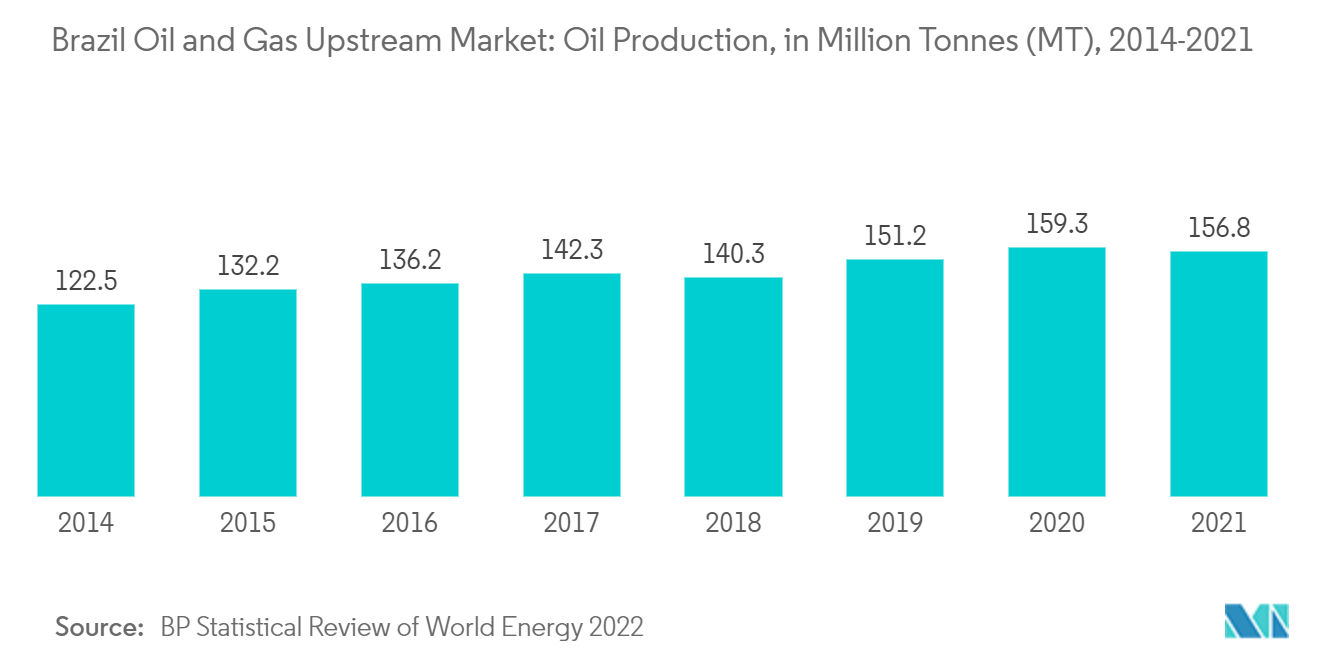Market Trends of Brazil Oil and Gas Upstream Industry
This section covers the major market trends shaping the Brazil Oil & Gas Upstream Market according to our research experts:
Increasing Oil and Gas Production Expected to Drive the Market
- As of 2021, Brazil is the major country in South America in terms of oil & gas spending. The country's offshore pre-salt oil fields pumped around 50% of the total oil output and this share increased to approximately 75% by the end of 2020. This increasing production and dependency on offshore oil & gas fields can be attributed to steadily decreasing production expenses due to improved drilling technology, growing expertise in offshore oil & gas industry, and increased infrastructure.
- Natural gas production in Brazil has more than doubled in one decade, reaching over 48.8 billion cubic meters in 2021. In comparison to the previous year, this represents an increase of almost five percent. Brazil's natural gas production is mainly concentrated offshore.
- Petrobras has plans to invest around USD 68 billion for the period 2022 to 2026. Of this total investment, 84% is allocated to the exploration and production (E&P) of oil and natural gas. Of the total E&P CAPEX (USD 57 billion), around 67% will be allocated to pre-salt assets. This indicates that the upstream oil & gas sector, especially the offshore oil & gas assets in Brazil, are expected to witness significant investment during the forecast period.
- In October 2022, State-run ONGC Videsh Ltd. (OVL) is planning to invest around USD 1 billion in a Brazilian offshore hydrocarbon block. OVL's decision to invest follows the declaration of commerciality (DoC) for the BM Seal-4 block. The block lies in the Sergipe Alagoas Offshore Basin in a 320 sq. km area.
- As of June 2022, there are around 7 active rigs operating in the offshore areas and 3 active rigs in the onshore areas of the country. As of 2021, the floating assets such as Floating Production Storage and Offloading (FPSO), Drillships, semi-submersibles, and Floating Storage and Offloading (FSO) accounted for more than 80% of the active offshore platforms in the country. This, in turn, indicates the dominance of offshore floating assets in Brazil's upstream oil & gas industry.
- Hence, such a scenario indicates that increasing oil and gas production is expected to drive the Brazil oil and gas upstream market in the forecast period.

Offshore Segment to have Significant Growth
- The deep-water and ultra-deep-water activities directly influence the Brazilian oil and gas upstream market in the offshore. After oil prices fell in 2014, many countries shifted toward onshore projects. Still, it turned out that the return investment period of onshore projects is 10 to 15 years. So, Brazil started deep-water and ultra-deep-water explorations, which are more profitable, having a return investment period of 5 to 6 years and this factor has helped the Brazilian oil and gas upstream market grow.
- According to the National Agency of Petroleum, Natural Gas, and Biofuels (ANP), in 2021, out of the total oil and gas production in the country, 96% is offshore, and only 4 % is from the onshore. This is expected to drive the Brazilian oil and gas upstream market in the forecast period.
- Oil production in Brazil has been on a mostly upward trend for over a decade, reaching nearly 156.8 million tonnes in 2021. This represents an increase of around 40 percent in comparison to a decade earlier. Petrobras, the national oil corporation, is by far the leading crude oil producer in Brazil, accounting for more than 90 percent of the national output.
- Libra oil field in Santos Basin in Brazil is an ultra-deep-water basin, is the largest oil field in Brazil, is under development phase, and is expected to complete by end of 2022. The development is expected to use several units of coiled tubing for directional drilling, well intervention ad well completion.
- In September 2022, Helix Energy Solutions Group, Inc. announced that it entered into a two-year extension of its well intervention charter and services contracts with Petróleo Brasileiro S.A. (Petrobras) for the Siem Helix 2 well intervention vessel offshore Brazil.
- Moreover, in October 2022, Norway's oil major Equinor has started production from the Phase 2 development of the Peregrino heavy oil field offshore the Campos basin in Brazil. Production from the Peregrino field is being carried out through a new well head platform and drilling rig called Peregrino C. The new platform is installed in a water depth of 120m.
- Therefore, activities in offshore are likely to increase and have a positive impact on the Brazil oil and gas upstream market in the forecast period.


